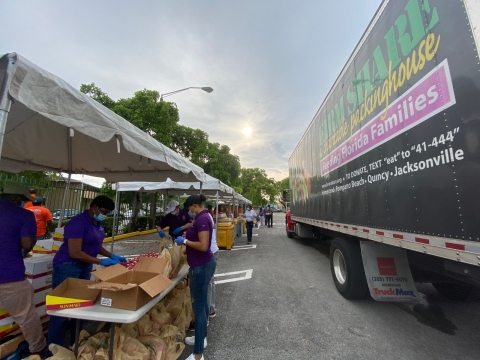Food distributions combat hunger during pandemic
Author
Upcoming Events
Related News

With 30 million Americans filing for unemployment because of the COVID-19 pandemic, people are facing another challenge that comes with losing their jobs: Putting food on the table.
“There’s nothing more important than providing food,” Essex County, N.J. Executive Joseph DiVincenzo, Jr. said. “People have to eat.”
In Essex County, a diverse community made up of both suburban and urban areas including Newark, DiVincenzo said the county’s unemployment rate is always higher than the national average.
“We have people in Essex County who are hurting very much,” he said. “Not only do we have homeless, we have people who are laid off. We have people who have been laid off for the first time probably ever in their life.”
To help county residents who are struggling purchasing food, the county is holding a series of emergency drive-through food distributions.
During the first distribution, the county partnered with Community Food Bank, an anti-hunger organization. DiVincenzo and his staff placed over 2,000 boxes of food — the equivalent of 40 meals per week — in the trunk of each recipient’s car.
Each box contained canned fruit and vegetables, spaghetti, shelf-stable milk, soup, tuna fish, oatmeal, peanut butter and other items.
During the first distribution, they had to turn cars away.
“At that time when I was there at the site, I knew that we had to continue this program,” he said.
DiVincenzo is taking the free food distributions throughout Essex County and has held distributions in various communities with the plan to hold 10 in different locations. For the rest of the distributions, the county is purchasing food through vendors like Shop Rite and being reimbursed for the spending by the CARES Act.
“The people who were there say, ‘thank you,’ but you can see the look on their faces,” he described. “They’re very much appreciative of what we’re doing, but they don’t want to be there. They’d rather be working and providing their way.”
In Nassau County, N.Y., County Executive Laura Curran launched Nassau’s Community Food Distribution Initiative to combat food insecurity issues on Long Island outside of New York City.
To hold the distributions, Curran set aside federal money that’s reimbursable through the CARES Act to buy food to support Island Harvest, a non-profit with food banks and food pantries.
The county partnered with the organization to set up distribution sites to hand out food items which included meat, yogurt, dairy, fruit and vegetables, canned food and pasta — enough food for a typical family for one week.
Each distribution covers around 900 to 1,000 people, with one site even seeing 1,300 recipients with individuals standing in lines snaking around several blocks.
The county has held drives at multiple locations with plans for more.
“We’re feeling the economic devastation here,” she said. “We have a lot of small businesses… a lot of mom and pop shops that can’t operate right now and people aren’t working.”
In Nassau County, SNAP applications tripled in April compared to April 2019, according to Curran.
“It’s going to take a long time to recover so the more the government can help get food to people, get resources where they need to go, that’s why we’re here,” she said.
In Florida, officials in Miami-Dade County are sponsoring various food distribution events to help those dealing with food insecurity.
Chairwoman Audrey Edmonson partnered with two organizations, FarmShare and Feeding South Florida, to hold free food distributions as well as deliveries for county residents in need.
During the distributions, recipients drive through the opening of a gate where volunteers instruct them to pop their trunks, Edmonson said. The food is placed in their trunks with items including frozen beef, canned goods, bread, cheese, orange juice, fresh fruit, raisins and vegetables, among others.
“You name it, we have been serving it,” she said.
One food drive distributed meals to 500 families and delivered 120 meals. Another fed 700 families and completed 50 deliveries, according to Edmonson.
For deliveries, county trucks and county employees bring boxes of food to the elderly and disabled who have called and expressed concerns over obtaining food.
“I want to do these deliveries as often as we can because we do have elderly who are shut in and have not been leaving their homes and they have to eat as well,” she said.
Edmonson said she noticed a difference with current food distributions reaching a different demographic of middle-class recipients.
“You have people who have been living check to check,” she said. “Even if they had another month’s worth of funding to pay their bills, they’re out of those funds now and that’s why you’re seeing the different categories of people coming in.”
Edmonson’s colleague Commissioner Joe Martinez has also sponsored food drives throughout the county with South Florida and Farm Share. For his first distribution, over 1,200 families received food.
“We are noticing that if we put the flyer out for a 9 a.m. start to the distribution, some people are lining up in their vehicles at 1 a.m., 2 a.m. with children,” he said. “The indication of that was that people were hurting really badly.”
Martinez emphasized the important role of county officials who are familiar with their districts and aware of areas facing food insecurity.
“It’s ground level roots helping out,” he said.

Attachments
Related News

County Countdown – Dec. 15, 2025
Every other week, NACo's County Countdown reviews top federal policy advocacy items with an eye towards counties and the intergovernmental partnership.
Stretching small opioid settlement allocations helps funding do more
States and localities are set to receive $56 billion in opioid settlement dollars over an 18-year period, but not every county that receives settlement funding will get enough to build out infrastructure.

